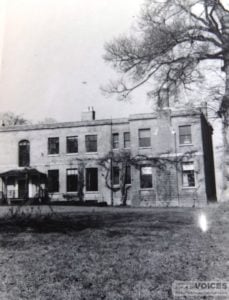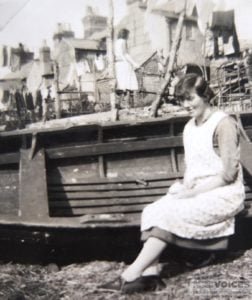My aunt Ena was housekeeper at The Mount and lived in, in the servants’ quarters. She was the only live-in servant left and was responsible for the housekeeping, and did all the cooking. My mum used to go in to help, so I was often there when I was small. Mrs Lansdowne and Mrs. Dye used to come in too, to help. It was a huge house – 32 main rooms as well as servants’ quarters and all the outbuildings.
The Mount photographed by Ruth Mills c1960

The Mount, home of the Dashwood family, photographed by Ruth Mills in 1960s.
Ruth’s mother and Aunt Ena worked at The Mount, with Ena ( Doe), last live-in servant.
Miss Constance was last surviving member of the family, all of whom died childless. The House was pulled down in 1966 to make way for the new road.
Miss Constance, who was the last surviving Dashwood, was very short, quite tiny but rather dumpy.
She came down to the kitchen to see Aunt Ena at exactly the same time every day, to give her the menu for the day. If I happened to be there, I had to hide in the scullery and not be seen. Whether my mum and my aunt had decided that children shouldn’t be seen, or whether Miss Constance had made that rule, I don’t know. I was certainly discouraged from going into the main part of the house.
The main rooms in the house seemed to be just as they were when the Dashwood family first lived there – very Victorian. The furniture had to be polished every day – one of the jobs I did to ‘help’ Mum.
There was a massive cupboard in the kitchen full of sacks of dried food like lentils and haricot beans. On one wall there were rows of bells to show which room you were being called to. The back stairs for the servants were steep and had a rope instead of a handrail, and there were long dark corridors with stone floors leading to the main house.
I used to go down into the cellars, lots of dark rooms with high windows with grills over them, where there always seemed to be lots of toads. There was an enormous boiler down there too, which I don’t remember ever working.
The smell of the stables is still easy to imagine, musty, with strange smells coming from the canvas hood of an old invalid carriage. The horses had all gone and there were no cars there – the stables wouldn’t have been big enough.
Mr. King, the gardener, grew all the vegetables for the house and there was a wonderful apple store with racks of apples that smelled really good.
I spent a lot of time wandering about outside on my own, quite happy. Once I was sent to pick daffodils – there were thousands growing there. Outside the back entrance there was a big old laburnum tree. If I climbed up and sat in the branches, I could see over the wall everyone coming and going in Back Lane, and they couldn’t see me. It’s left me quite content even now to be on my own. Ruth Mills nee Kelleway b 1945




